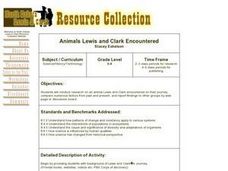Curated OER
Learning Activities: Magic Words
Students use poetry to compare and contrast humans and frogs.
Curated OER
How Are the Eyes of Different Organisms Adapted for Sight?
Students compare/contrast the human eye to two other organisms. They use micro viewers to identify the human eye structures, complete a Venn diagram worksheet, identify the function of each eye structure, and answer discussion questions.
WolfQuest
The Return of Gray Wolves to Yellowstone National Park: Right or Wrong?
Should gray wolves be removed from Yellowstone National Park? After researching the complex relationships between the various habitats and species at Yellowstone National Park, including humans, class members take a position on the...
Curated OER
All About Teeth
Chomp chomp! Learn which teeth perform which tasks with a thorough worksheet on molars, incisors, and canines. Based on descriptions of each kind of tooth, fifth graders label a diagram that points to particular teeth. They then color in...
Carolina Biological Supply
Kids, Giraffes, and Neck Bones
Everyone knows giraffes have longer necks than humans, but how do our neck bones compare to theirs? Learners examine a human vertebrae X-ray, counting the bones and predicting how many might be in a giraffe neck. They use a research site...
eSkeletons
Skeleton Scramble Puzzle: Suborder Prosimians
Explore the finer details of primate skulls with these puzzles, incorporating advanced scientific analysis of two suborders- Prosimians and Anthropoidea- and one superfamily- Hominoidea. Learners read about the unique characteristics of...
ReadWriteThink
Teaching Point of View With Two Bad Ants
What better way to explain the concept of point of view than from an ant's perspective! After reading Two Bad Ants, pupils identify the point of view of the ants by studying the text and pictures. Then, they fill out a chart that...
American Museum of Natural History
Race to the South Pole
Antarctica was the last continent humans explored. Explore how two teams raced to be the first using an interactive online lesson. Users learn about the climate challenges and how the teams sought to overcome them. The resource is...
Curated OER
Manduca
Young scholars investigate the basic survival needs of both hornworms and humans. They compare and contrast the them by making a class list.
Curated OER
Animals Lewis and Clark Encountered
Pupils conduct research on an animal Lewis and Clark encountered on their journey, compare numerous factors from past and present, and report findings to other groups by web page or discussion board.
Curated OER
Polar Day: Comparing My Community to a Northern Community
Third graders practice their geography skills. In this Polar Day-themed lesson, 3rd graders use their research skills to compare and contrast the place, regions, and human systems in their community to a Canadian northern polar region...
Curated OER
Temperate Forests vs. Wetlands
Students compare and contrast the temperate forest and wetlands by researching them in groups. In this forest lesson plan, students identify the economic, ecological, and social benefits of each.
Curated OER
Stormy Weather
Fifth graders compare human and wildlife environments. In this stormy weather lesson, 5th graders imagine they are an animal or human during a storm. Students compose a story with comparisons and reasons for how an organism's habitat...
Curated OER
Beautiful Bovine
Students compare and contrast a human body to a cow. Using a diagram, they label and identify the functions of the cow's numerous parts. In groups, they create a Venn Diagram to compare the various types of cows with one another. They...
Curated OER
Animal Life Cycles
Students participate in numerous activities to gather information about parts of the life cycle. In this life science lesson, the teacher choose from a number of activities to create or support an interdisciplinary unit about the life...
Curated OER
Do You Need What I Need?
Student identify the basic human needs. In this life science instructional activity, 3rd graders compare the needs of plants, animals and humans. They apply what they have learned by playing a survival team game.
Curated OER
The Boy in the Striped Pajamas: Anticipation Guide
Let your learners voice their opinions on morals and human rights with an anticipation guide for Asa Butterfield's The Boy in the Striped Pajamas. Before reading the novel, kids read several statements that encourage them to agree or...
Curated OER
Digestive System
The focus of this presentation is the digestive system of livestock animals. The simple digestive system of swine is compared to the complex digestive system of a cow. Details of the ruminant stomach are presented, complete with a...
Curated OER
How is a Human Vacation Like an Animal Migration?
Students compare animal migrations with human vacations. They consider the preparations involved, the purposes of travel and the consequences of any mistakes.
Curated OER
Ice Age Animals
Students research the ice age and the animals that were on the Earth at that time and have a debate on the explanation for the extinction of the ice age animals.
Curated OER
Herps and Humans
Learners compare and contrast the similarities and differences between the internal organs of herps--reptiles and amphibians--and humans.
Curated OER
Comparing Two Turtles
Students compare and contrast the various observable features of two different turtles. in groups, they complete a visual analysis of the sea turtle and tortoise. Using their observations, they complete Venn Diagram of the observable...
Curated OER
Fish Are Animals Too
Students create posters that show how a shark is a major predator in kelp forests and coral reefs after studying the food webs for these ecosystems. They determine that fish are important animals in the ocean's web of life.
Curated OER
So You Think You're Tough
Fourth graders learn how to classify animals. In this invertebrates lesson, 4th graders discuss how we classify thinks into groups and move into a discussion about classifying animals. Students learn about the differences between...

























